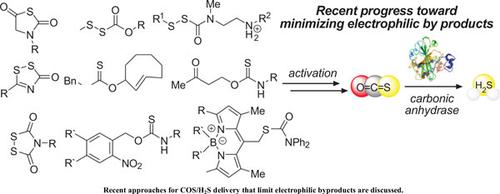Current Topics in Medicinal Chemistry ( IF 2.9 ) Pub Date : 2021-11-30 , DOI: 10.2174/1568026621666210622130002
Michael D Pluth 1

|
Hydrogen sulfide (H2S) is an important biomolecule that plays key signaling and protective roles in different physiological processes. With goals of advancing both the available research tools and the associated therapeutic potential of H2S, researchers have developed different methods to deliver H2S on demand in different biological contexts. A recent approach to develop such donors has been to design compounds that release carbonyl sulfide (COS), which is quickly converted to H2S in biological systems by the ubiquitous enzyme carbonic anhydrase (CA). Although highly diversifiable, many approaches using this general platform release quinone methides or related electrophiles after donor activation. Many such electrophiles are likely scavenged by water, but recent efforts have also expanded alternative approaches that minimize the formation of electrophilic byproducts generated after COS release. This mini-review focuses specifically on recent examples of COS-based H2S donors that do no generate quinone methide byproducts after donor activation.
中文翻译:

超越醌甲基化物:减少 COS/H2S 供体的亲电副产物的最新进展
硫化氢 (H 2 S) 是一种重要的生物分子,在不同的生理过程中起着关键的信号传导和保护作用。为了推进可用的研究工具和 H 2 S 的相关治疗潜力,研究人员开发了不同的方法在不同的生物环境中按需提供 H 2 S。最近开发此类供体的方法是设计释放羰基硫 (COS) 的化合物,该化合物可迅速转化为 H 2S 在生物系统中通过普遍存在的酶碳酸酐酶 (CA)。尽管高度多样化,但使用此通用平台的许多方法在供体激活后会释放甲基醌或相关亲电子试剂。许多此类亲电试剂可能会被水清除,但最近的努力也扩大了替代方法,以最大限度地减少 COS 释放后产生的亲电副产物的形成。这篇小型评论特别关注最近的基于 COS 的 H 2 S 供体的例子,这些供体在供体激活后不会产生醌甲基化物副产物。

































 京公网安备 11010802027423号
京公网安备 11010802027423号